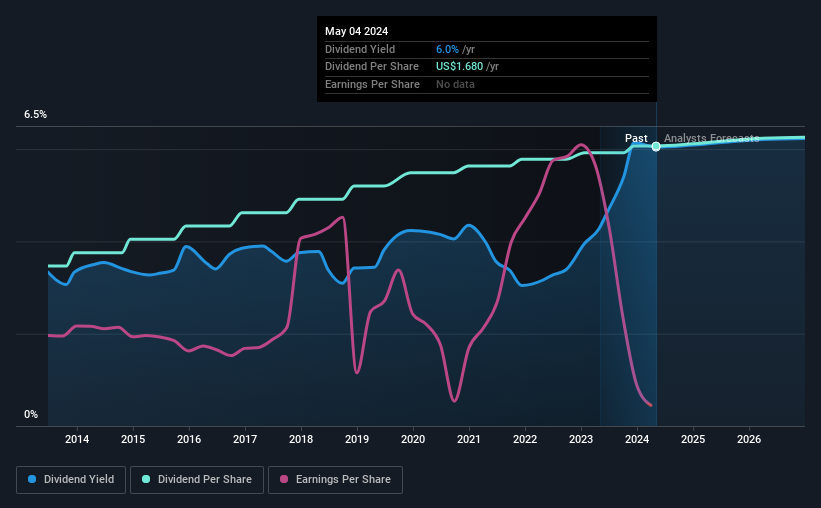Do These 3 Checks Before Buying Pfizer Inc. (NYSE:PFE) For Its Upcoming Dividend
Readers hoping to buy Pfizer Inc. (NYSE:PFE) for its dividend will need to make their move shortly, as the stock is about to trade ex-dividend. The ex-dividend date is usually set to be one business day before the record date which is the cut-off date on which you must be present on the company's books as a shareholder in order to receive the dividend. It is important to be aware of the ex-dividend date because any trade on the stock needs to have been settled on or before the record date. Accordingly, Pfizer investors that purchase the stock on or after the 9th of May will not receive the dividend, which will be paid on the 14th of June.
The company's next dividend payment will be US$0.42 per share, and in the last 12 months, the company paid a total of US$1.68 per share. Based on the last year's worth of payments, Pfizer has a trailing yield of 6.0% on the current stock price of US$27.81. Dividends are an important source of income to many shareholders, but the health of the business is crucial to maintaining those dividends. As a result, readers should always check whether Pfizer has been able to grow its dividends, or if the dividend might be cut.
See our latest analysis for Pfizer
Dividends are usually paid out of company profits, so if a company pays out more than it earned then its dividend is usually at greater risk of being cut. Pfizer lost money last year, so the fact that it's paying a dividend is certainly disconcerting. There might be a good reason for this, but we'd want to look into it further before getting comfortable. With the recent loss, it's important to check if the business generated enough cash to pay its dividend. If Pfizer didn't generate enough cash to pay the dividend, then it must have either paid from cash in the bank or by borrowing money, neither of which is sustainable in the long term. Pfizer paid out more free cash flow than it generated - 193%, to be precise - last year, which we think is concerningly high. It's hard to consistently pay out more cash than you generate without either borrowing or using company cash, so we'd wonder how the company justifies this payout level.
Click here to see the company's payout ratio, plus analyst estimates of its future dividends.
Have Earnings And Dividends Been Growing?
Stocks in companies that generate sustainable earnings growth often make the best dividend prospects, as it is easier to lift the dividend when earnings are rising. If business enters a downturn and the dividend is cut, the company could see its value fall precipitously. Pfizer reported a loss last year, but at least the general trend suggests its income has been improving over the past five years. Even so, an unprofitable company whose business does not quickly recover is usually not a good candidate for dividend investors.
The main way most investors will assess a company's dividend prospects is by checking the historical rate of dividend growth. In the past 10 years, Pfizer has increased its dividend at approximately 5.8% a year on average. It's good to see both earnings and the dividend have improved - although the former has been rising much quicker than the latter, possibly due to the company reinvesting more of its profits in growth.
We update our analysis on Pfizer every 24 hours, so you can always get the latest insights on its financial health, here.
The Bottom Line
Has Pfizer got what it takes to maintain its dividend payments? First, it's not great to see the company paying a dividend despite being loss-making over the last year. Second, the dividend was not well covered by cash flow." It's not that we think Pfizer is a bad company, but these characteristics don't generally lead to outstanding dividend performance.
With that in mind though, if the poor dividend characteristics of Pfizer don't faze you, it's worth being mindful of the risks involved with this business. Our analysis shows 2 warning signs for Pfizer and you should be aware of these before buying any shares.
Generally, we wouldn't recommend just buying the first dividend stock you see. Here's a curated list of interesting stocks that are strong dividend payers.
Have feedback on this article? Concerned about the content? Get in touch with us directly. Alternatively, email editorial-team (at) simplywallst.com.
This article by Simply Wall St is general in nature. We provide commentary based on historical data and analyst forecasts only using an unbiased methodology and our articles are not intended to be financial advice. It does not constitute a recommendation to buy or sell any stock, and does not take account of your objectives, or your financial situation. We aim to bring you long-term focused analysis driven by fundamental data. Note that our analysis may not factor in the latest price-sensitive company announcements or qualitative material. Simply Wall St has no position in any stocks mentioned.

 Yahoo Finance
Yahoo Finance 
